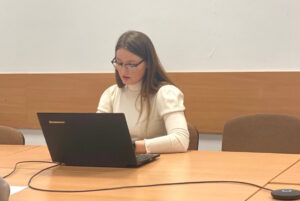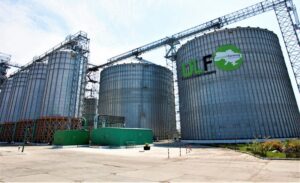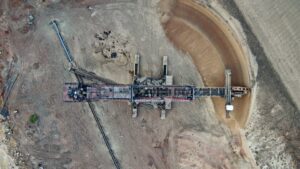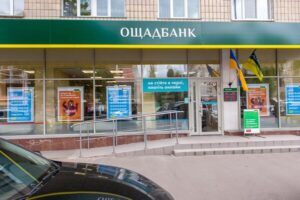
In March, the University of Łódź hosted an international scientific conference “Between the Reality of War and the Rhetoric of Peace”. The event was held under the patronage of the Voivode of Lodz and the Rector of the University of Lodz. This conference is a part of the Polish-Ukrainian art project aimed at popularizing the works of war artists, holding exhibitions of their works abroad, and publishing books about them as a way of their adaptation in peaceful life after the victory and overcoming the consequences of PTSD.
Aneta Pavlovska, Deputy Dean of the Faculty of Philosophy and History of the University of Lodz, Doctor of Science, Professor, who chaired the conference, emphasized the relevance of the project and spoke about the first such experience, the organization of 7 exhibitions of photographs by Captain Serhiy Belinsky, a press officer of the 28th separate mechanized brigade named after the Knights of the Winter Campaign, a famous musician and art photographer. Two catalogs of his works were published, scientific articles were written, and a monograph on Serhiy’s work in peacetime and wartime is currently being published at the Institute of Art History of the University of Lodz.

The following report was made by Yulia Ivashko, Doctor of Architecture, Professor at the Kyiv National University of Construction and Architecture, and press officer Serhiy Belinsky by phone from the Bakhmut direction.
The reports by Anastasia Urakina, a graduate student at the Kyiv National University of Construction and Architecture, and Agnieszka Gralinskey-Toborek, a doctoral student and professor at the University of Lodz, were directly related to the events of the war in Ukraine.
Anastasia Urakina presented a program of psychological rehabilitation and art therapy for people affected by the war, developed jointly with the Kyiv think tank “Experts Club“. The program primarily involves group work, which will be led by professional psychologists. Classes will be held at the “Experts Club“.
Anastasia Urakina’s theses on art therapy methods were a continuation of Ms. Agnieszka Gralinskay-Toborek’s discussion on which works of war survivors can be exhibited without harming the person, and which are only part of PTSD treatment.
It is worth noting that for the first time, Polish scholars had the opportunity to ask a Ukrainian artist at war questions live. Aneta Pavlovska asked how it is possible to remain an artist in the face of danger even in war. Serhiy answered that he has been in the army since 2021, he is used to it, his camera is always with him, and it is no less important for him than an information war with the enemy.
Yulia Ivashko showed a presentation of Serhii’s photographs and spoke about future plans to expand the circle of artists at war. The same point was emphasized by the Director of the Institute of Art History, Doctor of Science, Professor Piotr Gryglewski.
There were 18 presentations aimed at highlighting the work of military artists who experienced their own experiences, and the topic of war in art was also covered. Lukasz Sadowski, PhD, from the W. Strzemiński Academy of Arts in Lodz, highlighted the evolution of propaganda in Russian military painting.

Justyna Kobylarczyk and Dominika Kusznierz-Krupa, PhDs, professors at the T. Klczyuszko University of Technology in Krakow, who organized an exhibition Old-New Town at their university, showing Ukrainian cities before and during the war, said that such projects are needed.
Andriy Dmytrenko, PhD in Engineering, Associate Professor of National University “Yuri Kondratyuk Poltava Polytechnic”, highlighted the evolution of artistic messages during the war in Ukraine.
The conference ended with the presentation of the book “And the Light in the Darkness Shines” by Serhiy Belinsky and Yulia Ivashko about the war in Ukraine, published by the Krakow-based Impuls Publishing House.
ANASTASIA_URAKINA, ART, ART THERAPY, CLUB_OF_EXPERTS, CONFERENCE, KNUBA, LODZ_UNIVERSITY, PTSD, SERHIY_BELINSKY, YULIA_IVASHKO, АНЕТА_ПАВЛОВСЬКА

Ukrainian enterprises in January reduced exports of aluminum and its products by 33.7% compared to January 2022 – to $6.776 million, lead and its products by 41.4% – to $1.633 million, nickel and nickel products – $3 thousand, whereas in January 2022 it was $397 thousand.
Exports of aluminum and aluminum products for 2022 fell 42.7% from 2021 to $96.972 million ($6.330 million in December), lead and aluminum products fell 68.7% to $11.970 million ($1.396 million) and nickel and aluminum products fell 73.9% to $1.268 million ($0.1 million).

Ukrainian enterprises in January this year, reduced the import of nickel and its products by 96.2% compared with January 2022 – to $312 thousand, aluminum and its products – by 33.6%, to $26.529 million, while the import of lead and lead products reduced by 95.4% – to $32 thousand, tin and tin products by 20.4%, to $172 thousand, and zinc and zinc products – by 67%, to $2.238 million.
Ukraine has reduced imports of nickel and its products by 49.9% in 2023 compared to 2022 – up to $59.754 million ($0.668 million in December), aluminum and aluminum products – by 33.4%, to $340.398 million ($29.457 million). At the same time, imports of lead and lead products decreased by 66.6% to $2.839 million ($12 thousand).

This season the agricultural holding “Ukrlandfarming” is planning to sow 300-330 thousand hectares, which is more than a year ago, due to deoccupation, the owner of the holding Oleg Bakhmatyuk said to the agency “Interfax-Ukraine” on Monday.
According to him, about 30 thousand hectares in Chernihiv, Sumy and part of the Nikolaev regions are in question because of mines.
“Kherson, for sure, we will not have time for sure,” he said, adding that Ukrlandfarming lands in Donetsk, Lugansk, Zaporozhye and Kherson regions are still under occupation.
At the same time, Bakhmatyuk recalled that last year, the occupiers disrupted the sowing season in Kyiv, Chernihiv and Sumy regions.
The owner also said that significant changes will be in the structure of cultivated land, in particular the area under corn will be smaller, because it requires more investment, in contrast to, for example, sunflower.
In addition, Bakhmatyuk said that inspection of the Chornobaevskaya poultry farm from the “Ukrlandfarming” holding “Avangard” in the Kherson region showed the unrealistic resumption of its work in current conditions “neither for technical reasons, nor for people.
According to him, in fact, only poultry houses “with iron” remained at the factory, while all the climate control cabinets, all the engines and machinery were stolen. “Everything that could be unscrewed and broken off was unscrewed and broken off,” the owner of Ukrlandfarming stated.
He pointed out that in such conditions “Avangard” plans to increase production at the factory in Kamyanets-Podilsky.

In February of this year, Marganets Mining and Processing Plant (MMPP, Dnipropetrovs’k region) reduced its production volumes, in particular due to threats of shelling by the Russian occupiers, difficult weather conditions and lack of staff.
According to the company, February was quite difficult for MMPP: the work of all departments and divisions was affected by the difficult mining and geological conditions in the mines of the plant, weather conditions that significantly affected the operation of the Hrushevsky open pit, as well as the threat of artillery shelling by the Russian army from the temporarily occupied Enerhodar.
Therefore, the total production of crude manganese ore at MMPP amounted to 34,783 thousand tons, which is 4,816.7 tons less than the February target (87.8% of the plan), as mines No. 9/10 and 14/15 failed to meet their targets.
The only underground mining shop that met its targets was mine No. 3/5, which produced 206 tons above the plan, totaling 4,006 thousand tons of ore (105.4% of the plan).
Mine No. 9/10 fulfilled the February plan by 69.8%, producing 9207.3 tons of ore.
“These figures were affected not only by poor mining and geological conditions, frequent stops for manual work, crossing of drifts, but also by a catastrophic shortage of staff, who were mostly on sick leave,” the company said in a statement.
In turn, Mine No. 9/10 managed to meet its sinking plan by 116.9%, meaning that the tunnellers of this shop sank 76 linear meters of mine workings, even though they were manually sinking in the 15th southwestern drift on the last working days of February, the company said.
At the same time, it is noted that at the mine No. 14/15, there was a certain destabilization of the moral climate of the shop workers due to staff shortages, frequent equipment breakdowns and emergency downtime. As a result, the ore production backlog in February amounted to 1,030 tons (95.4% of the plan), and since the beginning of 2023, the shop has fallen behind by 2,378 tons. In total, the division’s miners mined 21.570 thousand tons of ore in February.
In February, Hrushevsky open pit did not mine crude manganese ore and a number of other operations. At the same time, the plan for conveyor stripping was fulfilled by 136.7 thousand cubic meters (109.4%), as well as the plan for re-excavation of rock mass by the non-transportation method by 52 thousand cubic meters.
For its part, Pokrovsky GOK (PGOK, formerly Ordzhonikidze GOK, Dnipropetrovska oblast) reports that the company is preparing to launch operations in April, having been idle since December 1, 2022, and that its concentrators have been shut down since October 1, 2022 (they do not produce concentrate) due to a shortage of electricity.
PGOK is the largest open-pit manganese ore producer in Ukraine. Four Cypriot companies – Profetis Enterprises Limited, Exseed Investmens Limited, Clemente Enterprises Limited and Alexton Holdings Limited (all from Cyprus) – own 24.3024% of the company’s shares.
As reported, in 2022, MMPP reduced its production of manganese concentrate by 41.2% year-on-year to 324 thousand tons.
In 2021, MMPP produced 551.43 thousand tons of concentrate (at the level of 2020).
MMPP is developing the eastern part of the Nikopol manganese ore deposit (Hrushevsko-Basansky area). The plant comprises four operating mines, including one under construction, one open pit mine – Hrushevsky – and a concentrator.
According to the company’s data as of the end of June 2022, the largest shareholders of the company are Couttenmax Holdings Limited, Mosfilia Investments Limited and Humax Enterprises Limited, which own 23.89% of the company each, as well as Fianex Holdings Limited (all Cyprus), which owns 24% of the shares.
The authorized capital of MMPP is UAH 366.625 million, with a share price of UAH 0.25.

State-owned Oschadbank (Kyiv) has launched an online lending service for clients of the micro/small and medium business segment (MSME), said Natalia Butkova-Vitvitskaya, member of the bank’s Management Board responsible for MSME, at a forum dedicated to digital lending and finance – Digital lending 2023.
“Any client regardless of its legal form of ownership can get a preliminary decision in 24 hours, provide a list of documents and get a final decision through this service,” explained a representative of Oshchadbank.
Butkova-Vitvitskaya noted that the average micro-business credit check through the new service is 1.5 million UAH, small businesses – 5 million UAH, medium-sized – 10 million UAH.
“Prior to that four banks in the Ukrainian market offered similar financing, but only for one segment of customers – FLP. Today I can say that Oschadbank is destroying the “myth” and makes the first step to the legal entities”, – emphasized the member of the board.
Oschadbank was created in 1991, and its sole owner is the state.
According to NBU, on January 1, 2023 it ranked second by total assets (UAH 298.2 billion) among the 67 operating banks in the country.